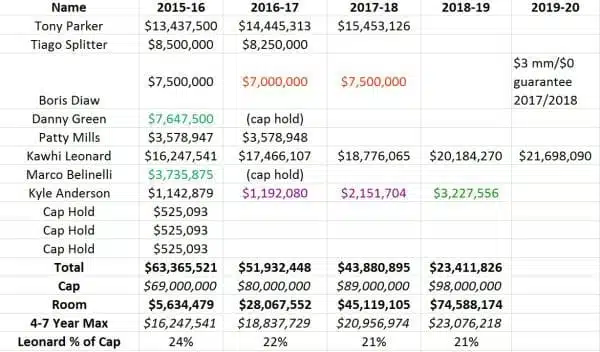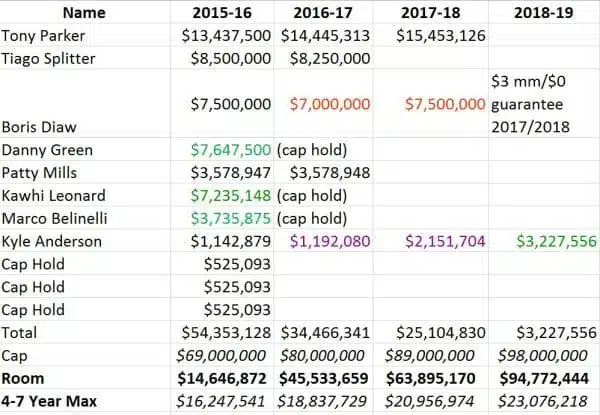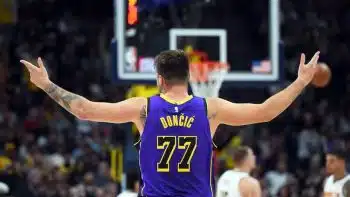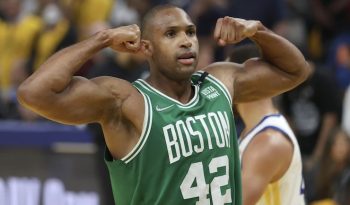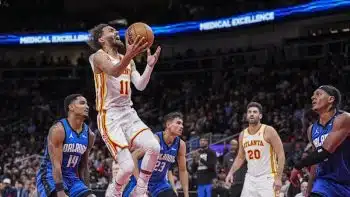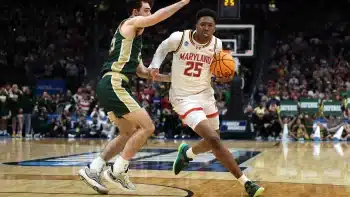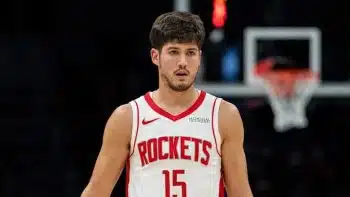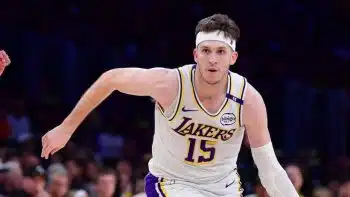NBA
NBA Rookie Extensions: Kawhi Leonard
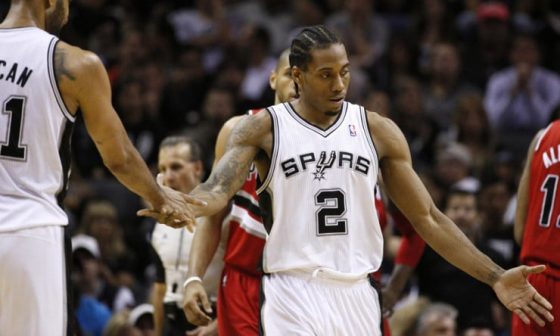
The 2014 rookie-extension class is one of the most interesting in several years due to the high number of quality players entering their fourth seasons. As most readers likely know by now, teams have until October 31 to reach extensions with first-rounders entering their fourth seasons or the players become restricted free agents next summer. This year, many of these players fall into the fascinating middle ground between total busts and obvious max outs, and their negotiations are further complicated by the unknown effect of the league’s recently-announced new TV deal.*
Over the next couple weeks, we will take a look at some of the more interesting cases, beginning with a player whose negotiations are a lot more interesting than they would appear at first blush.
Kawhi Leonard
Age: 23 (June 29, 1991)
Drafted: No. 15
2013-14 PER: 19.43
2013-14 ORPM: 0.89
2013-14 DRPM: 2.13
2015-16 Cap Hold: $7,235,148
Potential storylines abound in the extension talks with the third-youngest Finals MVP in NBA history. Kawhi Leonard has been called the San Antonio Spurs’ future by Gregg Popovich, and he is the only potential young star on the roster. Considering the fact that Gordon Hayward and Chandler Parsons, both inferior players to Leonard, received maximum deals as restricted free agents last offseason, a max extension may seem fait accompli to many.
On the other hand, the Spurs are widely perceived as consistently corralling their stars at below-market “unselfish” deals. Perhaps, some will think, that will result in Leonard doing the same. But those who don’t believe Leonard will seek to get his are ignoring quite a few factors. First, this is Leonard’s first big contract. By the end of his fourth season, he will have only pocketed about $8 million, about half of which was lost to taxes.
Second, Leonard is agent Brian Elfus and Impact Basketball’s biggest basketball client, per DraftExpress. Anything less than the max for Leonard (when it is widely perceived a foregone conclusion) might be seen as a failure, which is certainly a consideration for any agent.*
Third, the Spurs’ “tradition” of getting players to take less money amounts to essentially only one contract, this latest three-year, $30 million pact with Tim Duncan. If you really look at the market and their performance at the time, previous contracts for Duncan (before 2012), Tony Parker and Manu Ginobili were market rate—they just turned into great deals as those players aged much better than expected. Expecting the Spurs to get Leonard to take less based on this “history” has little basis, especially considering those players had already made plenty of money and this is Leonard’s first big deal.
Thus, I think we can count on Leonard and his agent negotiating as hard as possible, as they should. But the Spurs did not get where they are by overpaying for players. Indeed, the fact that the two sides have yet to agree on an extension would indicate that they too are taking the negotiations seriously. In past years, we have seen five-year Designated Player maximum extensions for John Wall, Paul George and Kyrie Irving agreed to well before this point. If the Spurs had offered that, the deal would have been done already.
Despite the fact that Leonard is widely presumed to be worth the max on the open market, the Spurs have a number of reasons not to offer it at this point. Leonard is so good other teams may be loathe to offer him the max in the summer of 2015, tying up their cap space for three critical days knowing the Spurs will undoubtedly match. A matched contract would have lower 4.5 percent annual raises, a potential advantage to San Antonio in the later years of the deal as the cap rises. And if Leonard is not extended an offer sheet by another team, a la Eric Bledsoe this year, that could provide additional leverage for the Spurs to obtain a deal below the max next summer.
Waiting until next summer also allows the Spurs to offer a five-year contract without using up their Designated Player extension (although there are no potential candidates for it right now), or by offering a five-year contract for below the maximum.* A five-year contract locking up Leonard through age 29 at pre-TV increase rates could prove a big value for the Spurs by the end, and could also make Leonard’s deal more tradeable if needed.
Moreover, as with any rookie extension, the Spurs will obtain more information on Leonard’s performance if they wait until the summer. There is little risk that his price tag will go up significantly given he is already projected as a max player. And there is some performance risk, either through injury or a lack of development offensively. It must be noted that, while Leonard has been one of the best complementary pieces in basketball the last two years, he has not shown much indication he can be a primary creator yet. We should not foreclose such a possibility, but it is by no means a foregone conclusion. The Spurs of course will not wish for anything to happen that would negatively impact Leonard’s value, but if they wait they are protected in case something does.
On the other hand, Leonard has little leverage if he waits. He would be footing the risk of injury or performance decline by doing so. And even if he gets to restricted free agency, the payoff may be marginal because he could have trouble getting an offer sheet—which would give him smaller raises anyway.
He only has two options at his disposal to create some leverage. One is potentially taking the qualifying offer, as Greg Monroe did this year. But Monroe seems very unhappy in Detroit; it seems unlikely Leonard would take such a risk to get out of San Antonio. The scarier option for the Spurs would be the specter of a Chandler Parsons-style offer sheet, three years for the maximum with a player option for the third year. The Spurs are no doubt hoping to lock up Leonard for the maximum number of years to get value on the back end as the cap rises—being forced to match the Parsons three-year offer (which they almost certainly would) allows Leonard to either leave or force a re-signing at cap-inflated market rate after two years in 2017. Unfortunately for Leonard though, getting another team to make such an inevitably-matched offer could be easier said than done. The Spurs also may be hesitant to upset him through perceived low-balling, but that is probably less a concern than on other teams with worse cultures.
Now consider the Spurs’ greatest reason to wait: Leonard’s free agent cap hold will be only $7.2 million this summer, less than half the $16 million or so he would occupy if he receives a max extension now. That extra cash could be critical if Duncan and Ginobili retire after the season. The Spurs may have a better internal idea of their plans than we do, but their age, health and the Spurs’ performance this year all render those future plans at least somewhat uncertain.
If Duncan and Ginobili play another year, the Spurs will not have a realistic path to cap space even if they do not extend Leonard. Even if those stars are immediately re-signed to an amount similar to their previous salaries, that would not create much cap room for the Spurs. And even that would likely be extinguished if Danny Green is re-signed.
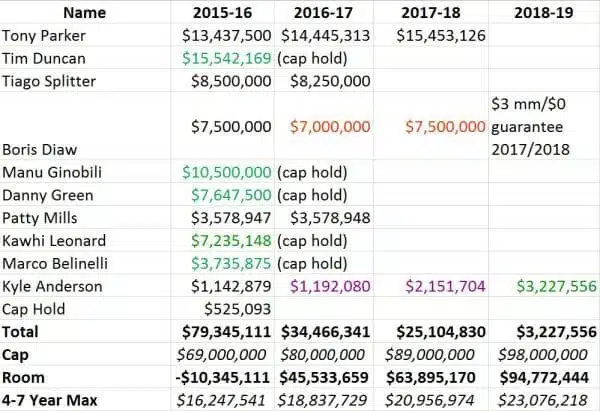
Let’s assume several things: The cap will be $69 million next summer, and $80 million in the summer of 2016. Those are obviously very rough and conservative estimates, but they track with some of the reporting by Larry Coon in this article, which indicates that the increase in the cap due to the TV deal may be smoothed into effect over a four-year period, resulting in approximately a $4 million per year increase on top of the “normal” cap increases. That will probably end up around $9 million per season starting in 2016-17. I included only the Spurs’ main players for this scenario in which the Spurs may try to lure free agents. Guys like Aron Baynes or Cory Joseph were left out because those players probably are not important enough to be retained at the expense of bigger fish. The 4-7 year maximum is computed based on a “cap” based on 42.14 percent of BRI rather than 44.74 percent. That’s why Leonard’s “25 percent max” is actually 24 percent of the actual cap to start.
Now, suppose Leonard is extended for the max, but Duncan and Ginobili announce their retirement. The Spurs still have little in the way of cap space. If Green and Marco Belinelli were renounced they might be able to squirm their way into fitting one maximum slot, but those are two valuable players the Spurs would be loath to renounce.
But let’s say the Spurs wait to sign Leonard, allowing him to become a restricted free agent. Now they have an additional $9 million or so in cap space, almost enough for a maximum salary to a player with 4-7 years of experience. Under this scenario, the Spurs would sign free agents up to the cap, then re-sign Leonard using his Bird rights, which would enable them to exceed it.
Renouncing Belinelli gets them there, and Patty Mills could be traded to get up to about $20 million, close to max territory for more experienced players. With Parker, Green, Leonard, Boris Diaw, Tiago Splitter and possibly Mills, the Spurs might be a very attractive destination for members of the 2015 free agent class, which could include LaMarcus Aldridge, Al Jefferson, Brook Lopez, Roy Hibbert, Paul Millsap, Luol Deng, any other 2011 draftees who do not sign extensions and others. The Spurs could also add a few lesser free agents to build their depth and remain competitive while trying for a bigger splash when the cap goes up much further in 2016. Replacing Duncan and Ginobili with players of that caliber could enable the Spurs to remain right in the championship mix.
The Spurs have a lot of leverage and some very good reasons for waiting on a deal. On the other hand, Leonard is, in the marketplace, a max player. Is there a middle ground? If the Spurs know Duncan and Ginobili plan to play next year, then that could be the impetus to get a deal done. But if not, Leonard would have to give up a lot of money in an extension to equal the potential lost opportunity in the summer of 2015 if the legends retire. Maybe the Spurs could offer a deal starting at the max but remaining flat or declining in salary rather than featuring the maximum 7.5 percent annual raises. But that would only save a few million per season at most on the back end of the deal, not the front, so it would not help in 2015. It seems unlikely Leonard would be willing to start much lower than the max, so there may not be a deal to be had here.
Perhaps the solution will be a wink-wink agreement on the structure of a deal once he becomes a free agent in 2015. Whether there is a preexisting arrangement or not, I think the best outcome here is Leonard re-signing in the summer of 2015, shortly after the Spurs have conducted their other free agent business, to a deal very close to – if not right at – the max. But unless he is willing to take a more significant discount than anticipated, it may not behoove the Spurs to extend him now.
